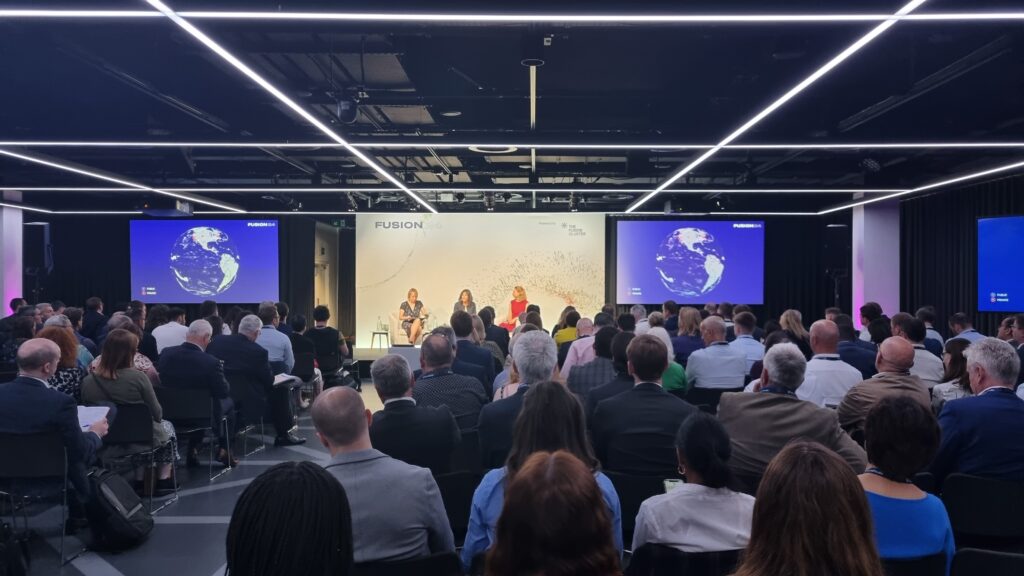
Welcome to the Kyoto Fusioneering blog! In this post, we are giving our highlights from the Fusion24 conference. Here is a firsthand account of the insightful sessions and the bold vision presented at the event, which took place at the Science Museum in London on Tuesday 18th June 2024.
The conference kicked off with Mark Maslin, a prominent expert in climate change at University College London, with a session titled “What Does a Fusion Future Look Like?” His presentation showcased the transformative potential of fusion energy, emphasizing its promise of providing abundant, sustainable energy to address global challenges such as climate change. Maslin’s insights set the stage for later discussions on how fusion technology can stimulate economic growth, enhance global security, and improve quality of life worldwide.

Melanie Windridge, CEO of Fusion Energy Insights, and Tammy Ma, a leading physicist specializing in fusion technology, and part of the team responsible for the breakthrough on the US National Ignition Facility (NIF), which demonstrated fusion net power gain in December 2022, led Fusion24 attendees on a whirlwind tour of the latest achievements in fusion energy. The session delved deep into recent progress across science, engineering, government policies, collaboration, and the broader ecosystem evolution. A fly-around of developments from around the globe showed new advancements from the US to Germany to Japan, all of which are propelling fusion closer to becoming a sustainable and scalable energy solution for the world.
One of the most captivating sessions at Fusion24 centered on the topic of funding fusion energy. Maria, Co-Head of Energy Transitions at Barclays, moderated a panel discussion that provided insights into how investors perceive and support investments in fusion. The session tackled not just the potential humanitarian benefits but also the financial considerations crucial to realizing fusion’s full potential.
Panelists Klaas de Boer, Marie Freier, Phil Larochelle, Andrew Lo, and Rory Scott Russell brought diverse perspectives to the table. They explored strategies to attract investors from both the public and private sectors, discussing financial and economic forecasts and identifying key funding gaps that must be addressed.
The speakers emphasized that harmonizing public and private funding is essential for speeding up the development and deployment of innovative technologies, particularly in areas such as clean energy and fusion power. Public and private funding each play unique but complementary roles, and their effective combination can lead to significant advancements.
Phil Larochelle, representing Breakthrough Energy Ventures (BEV), highlighted the organisation’s mission to accelerate the energy transition across all sectors of the economy. He explained that their investment focus is on visionary entrepreneurs who are building companies with the potential to significantly impact climate change on a large scale. Specifically, BEV invests in companies with technology that has the potential to cut global carbon emissions by at least 500 million metric tons annually. This commitment is why Breakthrough Energy Ventures has invested in fusion energy companies; a powerful signal of the deep potential for this technology to revolutionize the energy landscape for humankind.
Kyoto Fusioneering participated in the panel on safety and regulation titled “Maximising Opportunity, Ensuring Safety”. With Kyoto Fusioneering represented by our Co-founder and Chief Innovator, Richard Pearson, the panel discussed the UK’s proactive, risk-informed approach to regulating fusion energy. The UK government has appointed the Environment Agency (EA) and Health and Safety Executive (HSE) to oversee the development of next-step fusion facilities. During the panel discussion, Richard suggested this approach provides an “innovation sandbox” for development to proceed while risks are assessed comprehensively as more information becomes available. Importantly, the UK government will legislate to exclude fusion energy facilities from nuclear regulatory and licensing requirements, providing certainty and confidence for the industry. This strategy fosters investment and innovation in the sector while ensuring that regulations are developed appropriately. The panel emphasized the need for international cooperation to establish a unified regulatory framework, based on the same set of safety principles, even if different countries may take slightly different paths in how to regulate within their own jurisdiction. In this regard, Richard highlighted that the proactivity of the UK government, who have provided clarity on the regulation of prototype and demonstration fusion facilities, makes the UK a “great place to ‘do’ fusion”.

Fusion24 was more than a conference; it signaled continuous progress and change in the fusion industry. Kyoto Fusioneering was proud to sponsor this special event, which connected fusion activists, advocates, businesses, investors, the public, and other stakeholders in the fusion community. The journey towards a fusion-powered future is not merely a scientific endeavour but a collective aspiration for a better tomorrow. It requires collaboration across borders, disciplines, and generations to harness the transformative power of fusion energy for the benefit of humanity.
Subscribe to Our Newsletter
Follow Us on X, LinkedIn, Facebook




